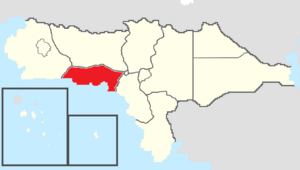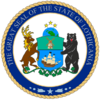Lothicania: Difference between revisions
No edit summary |
No edit summary |
||
| Line 11: | Line 11: | ||
|image_flag = State_Flag_Lothicania.png | |image_flag = State_Flag_Lothicania.png | ||
|flag_alt = Flag | |flag_alt = Flag | ||
|image_seal = | |image_seal = Lothicania_State_Seal.png | ||
|seal_alt = | |seal_alt = Seal | ||
|image_shield = | |image_shield = | ||
|shield_alt = | |shield_alt = | ||
Revision as of 23:09, 4 September 2021
This article is incomplete because it is pending further input from participants, or it is a work-in-progress by one author. Please comment on this article's talk page to share your input, comments and questions. Note: To contribute to this article, you may need to seek help from the author(s) of this page. |
State of Lothicania | |
|---|---|
State | |
| Nickname(s): The Liberty State (official) Gateway to Rizealand | |
| Motto(s): | |
 Map of Rizealand with Lothicania in red | |
| Country | |
| Before Statehood | Colony of Lothicania |
| Capital (and largest city) | Liberty City |
| Joined Federation | April 9, 1773 (2nd) |
| Government | |
| • Governor | Zoey Hagan (NPC-D) |
| • Deputy Governor | Tyler Richardson (NPC-ND) |
| • Legislature | Lothicania State Assembly |
| • Federal councillors | Appointed
Elected |
| • Federal representatives | |
| Area | |
| • Total | 97,409.49 km2 (37,610.01 sq mi) |
| Population (2021) | |
| • Total | 18,456,321 |
| • Density | 189.47/km2 (490.7/sq mi) |
| Time zone | UTC+9 to +10 (Western/Central) |
| Abbreviation | LO |
| ISO 3166 code | RZ-LO |
| Website | www |
Lothicania, known officially as the State of Lothicania and unofficially as "LO" or "Lothi", is a state in northwestern Rizealand that is bordered by Charlotte to the north, the Capital Territory to the northeast, Fáel to the east, the Vehemens Ocean to the south, and New Estmere to the west. Lothicania has a total area of 97,409.49 square kilometers, making it the eighth largest state and ninth largest political division of Rizealand. Lothicania also has a population of 18,456,321, making it the most populous state and political entity in Rizealand. Lothicania's capital and largest city is Liberty City. It is also home to several other large cities including Vehemens City, Vehemens Beach, and Marymore.
Etymology
The Colony of Lothicania was named after Gerald Ruyter, the Baron of Lothican, who led successful military campaigns against the Nehinaw in modern-day Lothicania, opening up the region for settlement by Estmerish settlers. After the Colony of Lothicania declared its independence from Gaullica leading to the Asterian War of Secession in 1764, it became the "State of Lothicania."
Geography
Lothicania is located in northwestern Rizealand and has a total area of 97,409.49 square kilometers, making it the eighth largest state and ninth largest political division of Rizealand. The highest point in Lothicania is the town of Waterville in Rogers County at 901 meters above sea level. The lowest point is the Vehemens Ocean at 0 meters above sea level. Located on the west coast of Rizealand, Lothicania has two large natural harbors along its coast. The largest harbor is Lothicania Bay and the second largest harbor is White Bay. Lothicania Bay is the largest natural harbor in Rizealand and is accessed by Liberty City, the largest city in Rizealand. Its location at the mouth of the Weanoke River, the largest river in Rizealand that extends across almost the entire length of the nation, makes it the busiest and most important port and trading location in Rizealand. The Weanoke River extends across Lothicania to the east where it forms the border between Lothicania, Fáel, and the Capital Territory. This part of Lothicania is in the Weanoke River Valley and is one of the most urban and densely populated areas in the state, including cities such as Liberty City, Nashua, Marymore, Richmark, Plycaster, and Anmore.
White Bay is accessed by the urban metro of St. Richards-Vehemens City and fed by the White River which runs through the center of the state, forming the White River Valley. Unlike the urbanized Weanoke River Valley in eastern Lothicania, the White River Valley is more rural with small towns and farms dotting its banks. The landscape of Lothicania is flat with no mountains except low rolling hills. The area west of the White River is mostly flat farmland and small towns, except for the Camasett Hills in Rogers County that mark the highest point in the state. Between the White River Valley and Weanoke River Valley are the Smoky Hills which are less densely populated than the surrounding areas, serving as a green belt and location for suburban development and expensive country estates.
Ecology
Historically, Lothicania was covered by temperate coniferous forest but today, temperate coniferous forest biomes only exist in a handful of small locations, replaced by deforestation and widespread urbanization. Where forests are still standing, there are different varieties of douglas fir, oak, maple, walnut, and ash. Other plants growing in Lothicania include bunch grass, festuca grass, rye grass, sedges, rushes, shadbush, blackberry, dogwood, snowberry, mouse ears, gentians, dandelion, aster, orchid, and roses.
Lothicania has many species of birds including loon, duck, goose, eagle, tern, seamews, snipe, heron, hawk, Asterian condor, owl, wren, thrush, hummingbird, sparrow, woodpecker, swallow, chickadee, warbler, finch, Asterian robin, crow, cardinal, new world oriole, meadowlark, blackbird, wild turkey, grouse, pheasant, and pigeon. Lothicania also has other land mammals including deer, Asterian black bear, muskrat, fox, mink, raccoon, opossum, skunk, marmot, cottontail rabbit, red squirrels, gray squirrels, ground squirrel, bushdog, and wildcat.
Reptiles and amphibians located throughout Lothicania include garter snake, kingsnake, rattlesnake, horned lizard, spiny lizard, side-blotched lizard, skink, painted turtle, pond turtle, salamander, and the frog. In the freshwater lakes and rivers throughout the state, there are trout, bass, perch, muskellunge, carp, bearded fish, and pike. Lothicania also has a variety of anadromous fish including pink haddo, silver haddo, king haddo, red haddo, and coastal cutthroat trout. Off the coast of Lothicania in the Vehemens Ocean or in coastal marine habitats, there are orca, dolphin, seal, sea otter, gray whale, humpback whale, sea bass, cod, Vehemens halibut, lobster, shrimp, clam, oyster, mussel, and crab.
Climate
Lothicania has a marine climate due to its location on the western coast of Rizealand. The state sees moderately dry summers with precipitation ranging from 3 to 2 inches a month and highs ranging from 67°F to 78°F. Winters are wetter with precipitation ranging from 10 to 13 inches a month and highs between 45°F and 53°F. On average, the state receives between 10 and 5 inches of snow a year, with more snow in the interior of the state than on the coast. Coastal Lothicania can be subjected to extratropical cyclones from the west which can range from minor to severe. Other natural hazards include flooding along major rivers like the Weanoke, wildfires in the forested areas of the state, and landslides.
Conservation
Lothicania has significant problems with deforestation as overlogging for commercial purposes and clearing of trees for farmlands have greatly reduced the number of forests in the state, compared to when it was first settled in the 1600s. The loss of habitat has caused a reduction in the populations of bear, deer, and other forest animals. Lothicania also has some of the worst water and air pollution in the country, due to it having numerous industrial centers and the largest urban area in the nation, Liberty City. Massive public transit networks in metros like Liberty City and a host of governmental regulations have kept the air pollution in the state's urban areas slightly below the national average but significant water pollution from industrial centers, farmlands, and urban areas remains a big issue. Lothicania also has issues with dwindling haddo populations due to water pollution and overfishing remains a problem for marine wildlife off the coast.
Below are a list of state preserves and reserves maintained by the government of Lothicania.

